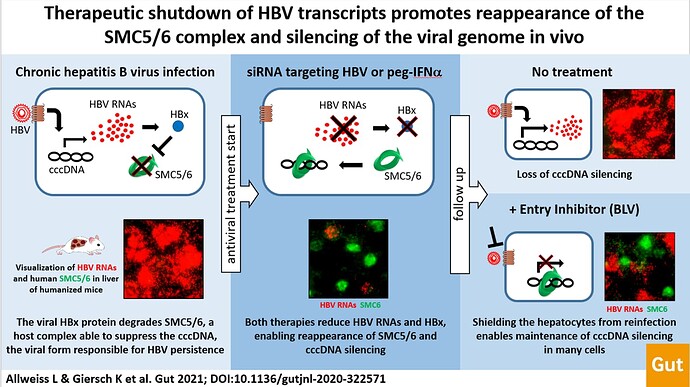Hi!
My name is Johannes and I‘d like to share my exciting M.D. project with you, supervised by Prof. Maura Dandri and Lena Allweiss at University Medical Centre Hamburg-Eppendorf.
You may have heard of the cccDNA, the main template for viral replication. Its stability and persistence in infected liver cells are one of the main reasons for chronic infections and the difficulties in achieving a functional cure.
When the cccDNA appears in the nucleus of a liver cell, it gets recognized and treated like our own DNA: wrapped around host proteins and organized in a chromatin-like way - the way our own DNA is contained. However, the human body developed ways to detect foreign DNA and one very important protein complex is called SMC5/6 (structural maintenance of chromosomes). It has been shown, that this complex effectively shuts down the cccDNA in infected cells, like a guard protecting a building from intruders. The problem is, that the virus manages to resist this defense mechanism and produces a viral protein (called HBx), that constantly impairs this guarding protein complex.
Our goal is to see which drugs lead to the reappearance of this SMC5/6 complex and understand the exact way the complex achieves this silencing process of foreign DNA. Most likely it happens transcriptionally, so on an epigenetic level - the level above the gene sequence, which determines, if a gene is on or off. All our studies are being conducted in mice, so our experimental setup is not far from the human body.
We established methods, to assess appearance of the SMC5/6 complex and gain insight into the epigenetic landscape of the cccDNA. Soon, we will be able to see, in which way the SMC-complex alters this epigenetic landscape and thus silences the DNA. That might lead to new information on how the silencing mechanism works, which could be an interesting model for new therapy approaches, working on a epigenetic level. If you can make sure that the SMC5/6 complex can carry out its functions, this could be a very effective way to shut down the virus in most of the liver cells. Our studies also confirmed that this silencing process is sustained for a longer period of time, suggesting a more persistent virus inhibition.
It has to be noted, that this project is basic research still, and even if the described processes turn out to be suitable for any treatment approaches, there is still a long way to go. Nevertheless, the project could soon lead to new insight into how the cccDNA is organized and regulated.
I think this is a very interesting topic and I am happy to share it with you. If you have any questions let me know. In the figure below you can see the graphical abstract of the paper our lab published 2 years ago. SiRNA and peg-INFa are two of many drugs we tested in our mice.
Thanks for reading and best regards,
Johannes
